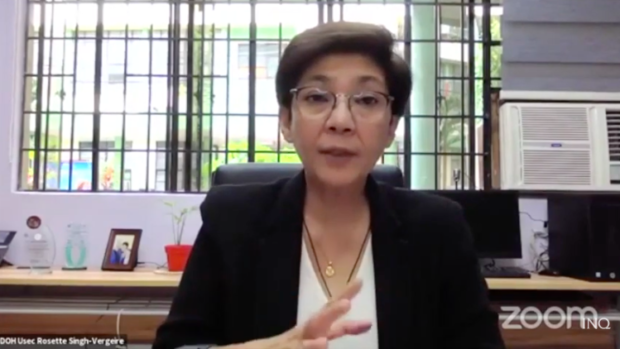DOH disputes OCTA assessment: Cases still up in some areas

FILE PHOTO Health Undersecretary Maria Rosario Vergeire explains a point during the DOH press briefing. Screengrab from livestream
MANILA, Philippines — Contradicting an assessment of the COVID-19 situation made by an independent research group, the Department of Health (DOH) said the country has not yet reversed the surge last July in coronavirus cases that was caused by the Delta variant of the novel coronavirus.
At her press briefing on Friday, Health Undersecretary Maria Rosario Vergeire said: “We cannot say that we have already reversed [the surge]. Because there are still ongoing cases. There are still areas with a high number of cases. There are still hospitals at full capacity.”
“We have to remain careful and not be complacent and [we should] continue to follow safety protocols,” she added.
On Thursday OCTA Research Group fellow Guido David said the country was back to its COVID-19 levels before “the Delta surge,” when daily cases averaged 6,000.
Local transmission of the Delta variant was first confirmed on July 16. This became the dominant COVID-19 variant, as infections rose to as high as 26,000 in September.
Article continues after this advertisementBut daily infections had record declines of 1,591 on Wednesday and 1,766 on Thursday, after an average 2,000 cases the week before.
Article continues after this advertisementYet on Friday, new cases breached the 2,000-mark at 2,376.
‘Endemic stage’
Vergeire also cautioned against declaring certain areas of the country to be at an “endemic stage.”
She said this was an epidemiological term that should not be used loosely.
According to the US Centers for Disease Control and Prevention, an endemic or baseline stage is a lower classification of the prevalence of a disease, the highest classification being a pandemic, followed by an epidemic.
David had said Cebu City was “probably close to what we call the endemic stage” because of its “very low” risk of COVID-19 transmission and its average of 15 infections per day.
He also identified Davao City, Metro Manila and the provinces of Rizal, Bulacan, Cavite, Laguna and Batangas as areas under moderate risk.
Vergeire, however, said “[T]here are criteria used before you can say that an area is already at an endemic stage [of] a disease.”
Virus case update
“When we declared malaria as endemic in the Philippines, … it took three to five years of observation, notations and tests among the general population,” she said.
With the new infections posted on the DOH bulletin on Friday, total COVID-19 cases were now at 2,797,986.
There were 37,377 active cases, of which 69 percent were mild, 5.4 percent were asymptomatic, 13.9 percent were moderate, 8.2 percent were severe and 3.5 percent were critical.
The department recorded 2,109 new recoveries, bringing total survivors to 2,716,524.
The death toll rose to 44,085 after 260 new fatalities were registered.
Of the 44,182 tests conducted last Wednesday, 2,872 came out positive.
This placed the positivity rate at 6.5 percent—still considerably higher from the World Health Organization’s recommendation of below 5 percent to indicate that COVID-19 infections are under control.
Four labs failed to submit their data on time, the DOH said.